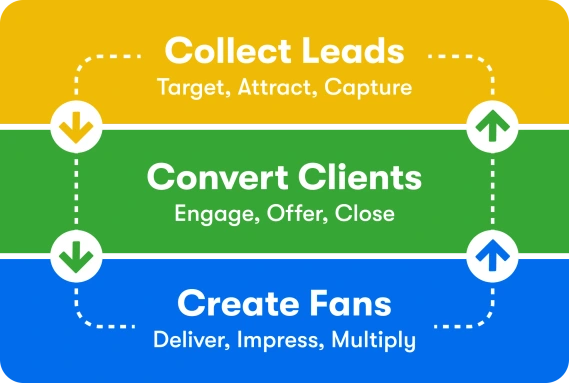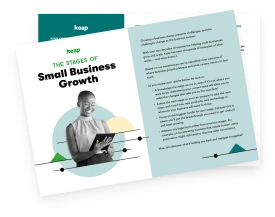Many small business teams are stuck on the hamster wheel of too many leads and not enough time, so some opportunities inevitably fall through the cracks. The manual processes and cobbled-together systems that got the business started just don’t scale well.
Or maybe the business has hit a growth ceiling: It needs more clients, but the only way to do that is to spend more money on advertising, which the company simply isn’t able to do, unless they get more clients, which would require more marketing dollars… you see the problem there.
This is where Lifecycle Automation comes to the rescue, enabling small businesses to grow sales, increase productivity and improve customer satisfaction.
How does Lifecycle Automation help small businesses?
Lifecycle Automation (LCA) is a framework for automating business processes based on your clients’ journey (aka, the customer lifecycle). It’s the process of giving your audience the experiences they need, want and like as they become prospects, then clients, then advocates of your small business.
When you use Lifecycle Automation to plug the gaps in your small business’s customer lifecycle, you can experience three major benefits:
- Increase sales without increasing advertising costs
- Provide a better customer experience that has clients coming back for more and referring you to people they know
- Free up your team’s time to focus on more important tasks
This can be one of the best goodwill-generating concepts in the world of digital marketing, and when properly executed, it provides ongoing financial returns.
Check out this video👇 by Keap co-founder Scott Martineau as he walks through how Lifecycle Automation plugs the gaps in small business marketing, sales and support funnels.
Wondering where the gaps are in your customer lifecycle?
Is Lifecycle Automation the same thing as Lifecycle Marketing?
You may have heard the term Lifecycle Marketing and wondered how it’s related to Lifecycle Automation.
Lifecycle Marketing was originally coined by Keap to help entrepreneurs and their teams understand the strategy behind how to implement Keap’s small business CRM and marketing automation software.
It was created because strategy is key to implementing automation correctly, in a way that feels more personal to your audience, not less personal.
It’s a proven growth framework created by Keap after working with thousands of small businesses for over 20 years.
In 2021, Keap started using the term Lifecycle Automation instead of Lifecycle Marketing to emphasize that automation is the key to making every phase of your Lifecycle Marketing efficient and sustainable.
The Lifecycle Automation strategy applies not only to marketing, but also to sales, customer service and internal processes. It’s about automating the easiest and best experience for prospects, clients, and employees.
How does Lifecycle Automation work?
Lifecycle Automation has three phases: Collect Leads, Convert Clients and Create Fans. Each phase consists of three stages.
Rolling out a customer Lifecycle Automation plan is a lot easier when done in these phases and can be done quickly and affordably with easy-to-use automation technology from Keap.
The Collect Leads phase
The goal of the Collect Leads phase is to get the attention of the consumers you want to buy your products or services and capture their contact information so you have permission to follow up with them. It’s made of up three stages:
- Target — Targeting is when you identify the type of person you want to attract as a customer, and customize your lead generation strategies to appeal to them. The most common ways to target an audience are by interests, behaviors, demographics, location, etc.
- Attract — Attract visitors to your website with great content like videos, ebooks, infographics, research reports, webinars, social media and blog posts.
- Capture — Use a web form to capture the contact information (and permission to communicate) of visitors, often in exchange for a free consultation or premium content.
The Convert Clients phase
Convert Clients is the second phase of the Lifecycle Automation model. This is your unique strategy that makes your product or service the obvious choice when those you’ve attracted are ready to buy. The three Convert Clients phases are:
- Engage — Create a consistent campaign of useful information with automated, personalized follow-up messages.
- Offer — The best way to craft an offer is to observe past customer actions and create a customer journey map, then provide an irresistible offer. It can take 7-12 follow-ups before a prospect is ready to buy, so automation is key at this stage.
- Close — Closing the sale is more than the transaction. Use automation to clearly communicate next steps to the new client and transition them smoothly from sales to customer support.
The Create Fans phase
This is the phase most often neglected by small businesses, because once a sale has been made, focus often turns back to converting more prospects into clients. Therefore, this may be your biggest goldmine of opportunity. The three stages are:
- Deliver — Fulfill your commitments to clients on time and follow through when and where it’s required. Treat customers with the same rapid response and attention that you show to prospects you’re trying to win over.
- Impress — Offer to provide additional value that surprises and delights customers. Always be developing strategies, tactics, products and services to help generate additional sales and recurring revenue from current and former clients.'
- Multiply — Encourage referrals by creating incentives for customers and partners. Automatically request reviews and testimonials from satisfied clients. Quickly identify and follow up with unhappy clients, and you may be able to turn disgruntled clients into advocates.
Many small businesses have been practicing Lifecycle Automation tactics in some form for a long time. What’s valuable about having the structure clearly laid out like this is that you can more easily identify where there are opportunities for your small business to create a better experience — and enjoy the rewards.
The Lifecycle Automation framework helps you move beyond sales and marketing as a collection of activities, and instead approach it as a single process that can be refined and optimized.
Take the Lifecycle Automation Assessment now to discover opportunities to improve your small business’s customer lifecycle.
What does it take to be successful at Lifecycle Automation?
To be a master of Lifecycle Automation, you need to have a genuine understanding of your target audience and be ready to work toward retaining and growing customer value over the long term.
By optimizing your client experience, you’ll make changes that lead to more sales, more advocates of your business, more impact in the world, and more freedom for you and your team.
Here are a few resources to help you get started:
Lifecycle Automation Assessment
Empathy Mapping: How to read your customer’s mind
How to Create a Customer Journey Map
Small business CRM and marketing automation
Take the Lifecycle Automation Assessment
Compare your business against the industry’s top performers to reveal the strengths and gaps in your marketing using our proven Lifecycle Automation Assessment.
Evaluate where you are today, identify areas of opportunity to strengthen your customer lifecycle, and prioritize the next best steps to take in order to reach your growth goals.
Complete the assessment and get your Lifecycle Automation score to see where your business stands compared to the thousands of small businesses Keap has served over 20+ years.
Kevin Lynch and Tracie Rollins contributed to this article.


